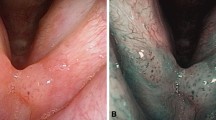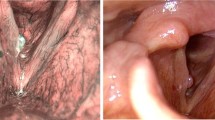Abstract
In the cases of uncertainty, even if the patient has no complaints about his voice quality, sometimes, benign vocal fold mass lesions are removed to exclude malignancy with the risk of resultant dysphonia. Narrow Band Imaging (NBI) enables a specific visualization of vessel structures in the superficial tissue. Benign lesions of the larynx are frequently characterized by abnormal vessel configuration or an absence of vessels in the area of the lesion. It was hypothesized that, in the primary diagnosis of patients with these benign lesions, the combination of white light and NBI endoscopy enables a better detection compared with white light endoscopy alone. Twenty-nine patients (eight patients with a cyst on a vocal fold, eight with a polyp, seven with a Reinke´s edema, two with a leukoplakia, one with a carcinoma, one with a granuloma, and two without any pathologic finding) were examined with normal white light and NBI endoscopy. 87 video sequences (29 white, 29 NBI, and 29 white/NBI) were generated and randomized and presented to 20 otolaryngologists who rated the videos in terms of the suspected diagnosis. Results were compared with the histopathologic findings of microlaryngoscopy. The probability of detecting benign lesions of the vocal folds was higher using NBI in combination with white light endoscopy compared with white light endoscopy alone. For vocal fold cysts, this difference was statistically significant. NBI endoscopy in combination with normal white light endoscopy improves the detection rate of benign lesions of the larynx, especially of vocal fold cysts.





Similar content being viewed by others
References
Graupp M, Bachna-Rotter S, Gerstenberger C et al (2015) The unsolved chapter of vocal fold scars and how tissue engineering could help us solve the problem. Eur Arch Otorhinolaryngol. doi:10.1007/s00405-015-3668-8
Hawkshaw MJ, Sataloff JB, Sataloff RT (2013) New concepts in vocal fold imaging: a review. J Voice 27(6):738–743
Nguyen P, Bashirzadeh F, Hodge R et al (2013) High specificity of combined narrow band imaging and autofluorescence mucosal assessment of patients with head and neck cancer. Head Neck 35(5):619–625
Ni XG, He S, Xu ZG et al (2011) Endoscopic diagnosis of laryngeal cancer and precancerous lesions by narrow band imaging. J Laryngol Otol 125(3):288–296
Bertino G, Cacciola S, Bastos Fernandes W, Muniz Fernandes C, Occhini A, Tinelli C, Benazzo M (2015) Effectiveness of narrow band imaging in the detection of premalignant and malignant lesions of the larynx: validation of a new endoscopic clinical classification. Head Neck. doi:10.1002/HED
Watanabe A, Taniguchi M, Tsujie H, Hosokawa M, Fujita M, Sasaki S (2008) The value of narrow band imaging endoscope for early head and neck cancers. Otolaryngol Head Neck Surg 138(4):446–451
Piazza C, Cocco D, De Benedetto L, Del Bon F, Nicolai P, Peretti G (2010) Narrow band imaging and high definition television in the assessment of laryngeal cancer: a prospective study on 279 patients. Eur Arch Otorhinolaryngol 267(3):409–414
Tjon Pian Gi RE, Halmos GB, van Hemel BM et al (2012) Narrow band imaging is a new technique in visualization of recurrent respiratory papillomatosis. Laryngoscope 122(8):1826–1830
Ochsner M, Klein A (2015) The utility of Narrow Band Imaging in the treatment of Laryngeal Papillomatosis in awake patients. J Voice 29(3):349–351
Dippold S, Becker C, Nusseck M, Richter B, Echternach M (2015) Narrow Band Imaging: a tool for endoscopic examination of patients with laryngeal papillomatosis. Ann Otol Rhinol Laryngol 124(11):886–892
Gökcan K, Dursum G (2009) Vascular lesions of the vocal fold. Eur Arch Otorhinolaryngol 266:527–533
Xinmeng Q, Dan Y, Xue Z, Chunshun J et al (2014) Clinical experiences of NBI laryngoscope in diagnosis of laryngeal lesions. Int J Clin Exp Med 7(10):3305–3312
Pickhard A, Reiter R (2013) Benign Vocal fold lesions. Laryngo-Rhino-Otol 92:304–312
Johns M (2003) Update on the etiology, diagnosis, and treatment of vocal fold nodules, polyps, and cysts. Curr Opin Otolaryngol Head Neck Surg 11:456–461
Arens C, Piazza C, Andrea M, Dikkers F, Tjon Pian Gi RE, Voigt-Zimmermann S, Peretti G (2016) Proposal for a descriptive guideline of vascular changes in lesions of the vocal folds by the committee on endoscopic laryngeal imaging of the European Laryngological Society. Eur Arch Otorhinolaryngol 273(5):1207–1214
Chen B, Lin H, Wu K, Lee K (2012) Subglottic cyst: the role of narrow-band imaging. Int J Pediatr Otorhinolaryngol 76:452–454
Rosen C, Gartner-Schmidt J, Hathaway B, Simpson C, Postma G, Courey M, Sataloff R (2012) A nomenclature paradigm for benign midmembranous vocal fold lesions. Laryngoscope 122(6):1335–1341
Acknowledgments
The authors would like to thank Helena Daffern, Ph.D., for native corrections. Matthias Echternach`s and Bernhard Richter`s works were supported by the Deutsche Forschungsgemeinschaft (DFG), Grant No. EC 409/1-1 and RI 1050/4-1.
Author information
Authors and Affiliations
Corresponding author
Ethics declarations
Conflict of interest
The authors declare that they have no conflict of interest.
Ethical approval
All procedures performed in studies involving human participants were in accordance with the ethical standards of the institutional and/or national research committee and with the 1964 Helsinki declaration and its later amendments or comparable ethical standards.
Informed consent
Informed consent was obtained from all individual participants included in the study.
Rights and permissions
About this article
Cite this article
Dippold, S., Nusseck, M., Richter, B. et al. The use of narrow band imaging for the detection of benign lesions of the larynx. Eur Arch Otorhinolaryngol 274, 919–923 (2017). https://doi.org/10.1007/s00405-016-4300-2
Received:
Accepted:
Published:
Issue Date:
DOI: https://doi.org/10.1007/s00405-016-4300-2




